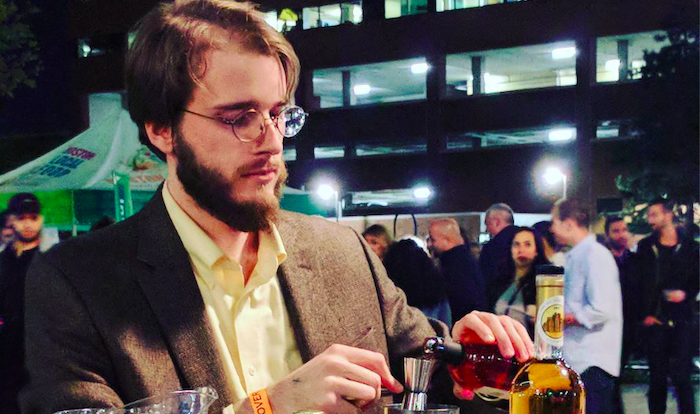
“It’s not just a list of what’s there, but also an investigation of how the ingredients are modifying the base spirit, and what dimensions of base flavor, texture or aroma they’re contributing to create the overall balance in the drink.”
Brian Hoefling is taking us back to cocktail school.
The Cambridge-based author, who operates the Herzog Cocktail School and has previously penned Distilled Knowledge: The Science Behind Drinking’s Greatest Myths, Legends and Unanswered Questions, published The Cocktail Seminars this past June through Abbeville press.
While The Cocktail Seminars could be classified as a recipe book—it contains 150 of them—they’re taught in a sequential, academic style, broken into five “courses.” The lesson begins with “The Survivors”—those staple cocktails like the Sidecar and Mint Julep that outlived Prohibition—and steadily builds up to “Topics in Contemporary Mixology,” which will have readers fat-washing bourbon as they try their hands at modern day creations.
And though you could open the book at random to make a Morning Glory Fizz (provided you have the ingredients), it’s intended to be worked on from start to finish to provide a succinct education in what makes a cocktail tick. “What I tried to do is guide people who are still learning how to make drinks through the process in a sequence that I think will be helpful or useful,” Hoefling says.
 To that end, each course begins with a list of required ingredients that are utilized multiple times throughout the following chapter and beyond, ensuring that readers won’t have to shill out for a pricey bottle or prep a labor-intensive component that won’t be used again.
To that end, each course begins with a list of required ingredients that are utilized multiple times throughout the following chapter and beyond, ensuring that readers won’t have to shill out for a pricey bottle or prep a labor-intensive component that won’t be used again.
“I try as much as possible not to just think of what the canonical drinks are, but also the canonical ingredients,” says Hoefling.
Crucially, each entry explains not only how to make the drink, but also how the drink’s different components interact to make it a success. To help break down this wonky approach to mixology, Hoefling has included a color wheel of his own design beside every recipe. The drink’s base spirit (e.g., “bourbon,” “blended scotch,” etc.) sits at the center of the wheel, which is divided into eight slices labeled with “sweeten,” “sour,” “lengthen,” and other descriptors, which are shaded in to reflect their role in the sum experience.
“It’s not just a list of what’s there, but also an investigation of how the ingredients are modifying the base spirit, and what dimensions of base flavor, texture or aroma they’re contributing to create the overall balance in the drink,” Hoefling says.
To make sure you’re paying attention, each course also includes “exercises” that challenge the reader to make a given cocktail with the ingredients listed but leave its proportions and preparations up to the reader (don’t worry: the solution is always printed upside-down on the opposite page). Every course concludes with a kind of capstone project (referred to as “examinations” in the first two courses and “final projects” in the latter three) that assign the reader increasingly complex tasks, like selecting the right ingredient volumes for mixing the many-faceted Ramos Gin Fizz or recreating the long-lost cocktail ingredient Amer Picon at home.
Though the cocktails the book teaches come from across the globe, savvy readers will recognize a number of drinks created in Boston bars past and present. There’s the most ubiquitous of Hub drinks, the 19th-century Ward 8 said to have been invented at Locke-Ober (now Yvonne’s), but also the Periodista birthed by longtime Cambridge bartender and present Cambridge City Council candidate Joe McGuirk; the Maximillian Affair first mixed at Green Street by Misty Kalkofen; the Red Maple Swizzle made by Jackson Cannon of Eastern Standard; and the Crème de Canne Collins as devised by the Hawthorne’s Jared Sadoian.
Hoefling hopes that by graduation day, his students will have familiarized themselves with the cocktail canon, paving their way for more creative postgraduate studies. “I am always very clear with people that when I give them a recipe, it’s a jumping-off point,” he says. “Not only do I expect that you will adapt a recipe I give you to your own tastes once you feel comfortable enough to do it, but I think you should.”
Eric Twardzik is a Boston-based writer and editor with extensive experience in branded copywriting and journalism with an emphasis on food, drink, travel and men's lifestyle.

